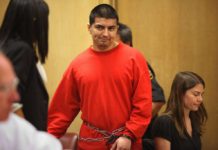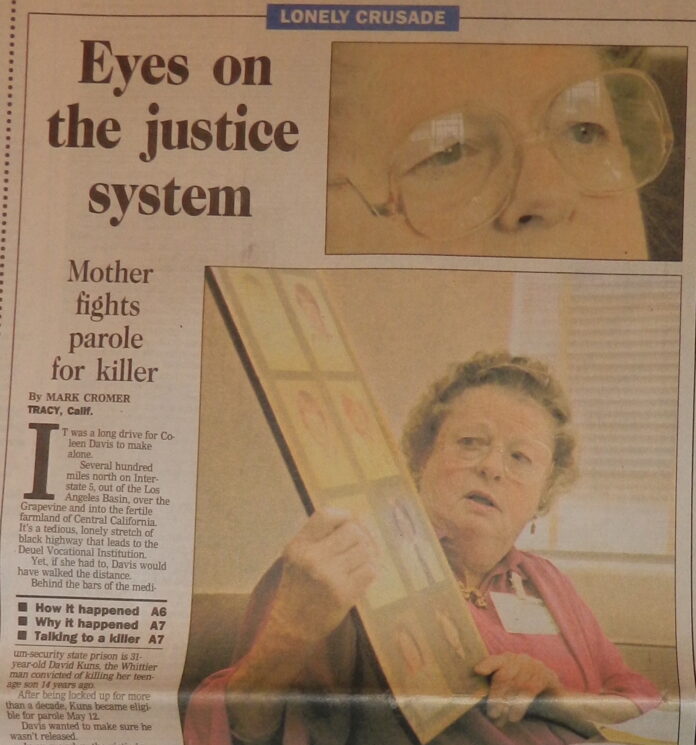
Eyes on the Justice System
Mother fights parole for killer
[As Sacramento continues to release thousands of violent career criminals on to the streets of California, I was reminded of the stories I wrote chronicling the desperate fight of Coleen Davis to keep her son’s killer behind bars. This was first published on May 24, 1993, by Thomson Los Angeles Newsgroup—the suburban daily newspapers of the Pasadena Star-News, San Gabriel Valley Tribune and the Whittier Daily News—as convicted killer David Kuns came up for parole. Both Davis and Kuns credited my reporting with keeping him behind bars. It is presented as a single feature article here.]
By Mark Cromer
It was a long drive for Coleen Davis to make alone.
Several hundred miles north on Interstate 5, out of the Los Angeles Basin, over the Grapevine and into the fertile farmland of Central California. It’s a tedious, lonely stretch of black highway that leads to the Deuel Vocational Institution.
Yet, if she had to, Davis would have walked the distance.
Behind the bars of the medium-security state prison is 31-year-old David Kuns, the Whittier man convicted of killing her teenage son 14 years ago.
After being locked up for more than a decade, Kuns became eligible for parole May 12.
Davis wanted to make sure he wasn’t released.
In an era when the victim’s rights movement is gaining momentum, state officials said it is still unusual for victims’ relatives to personally appear to argue against the release of a convict.
“We are seeing families more and more often than we used to,” said Parole Commissioner Ron Koenig. “(But) I would say it’s still rare. (Family members attend) perhaps 10 to 20 percent of the time. It’s important that they do come. It can have a tremendous impact,” he said.
Those representing convicts during the hearings have more conflicting feelings about families attending the proceedings.
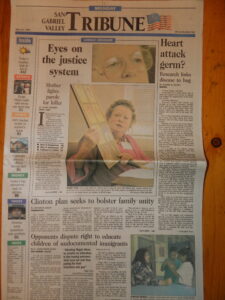
“It can be extremely uncomfortable, and for that reason alone I prefer they not be present,” said attorney Marcia Hurst, who was appointed by the state to represent Kuns.
“On the other hand, I have (sometimes) been grateful they have been there,” she said. “There are times when I feel (convicts) needed to be confronted by family members.”
Hurst said that of the more than 400 parole hearings she has participated in during the past five years she has seen only about 10 families attend the proceedings.
“I don’t know how much more difficult it would be to grant a parole date with a family present, but I’m sure it’s very tough,” Hurst said.
In a brief but at times intense drama, Davis faced Kuns and his attorney, arguing passionately against parole for an inmate who by many standards has been a model prisoner.
Played out inside a small conference room within the prison, the proceeding was devoid of any of the judicial pomp that surrounds court trials. Three commissioners from the state’s Board of Prison Terms served as the parole board.
The middle-aged men, all appointed by California governors, wore business suits and sat behind a long table. At one end of the table was a deputy district attorney from Los Angeles County, at the other was Davis and two journalists.
With the morning sun still cresting over the prison, guards ushered Kuns into the room to greet his fate. Hurst sat next to him. A guard stood behind him.
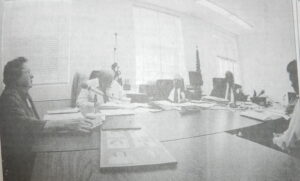
The room fell quiet as Kuns took his seat. The commissioners avoided eye contact with him, instead browsing through the stacks of files in front of them.
Wearing neatly creased blue prison denims, Kuns bowed his head and folded his hands as Commissioner Cleo Brown told him his case would not be retried but details would be discussed. Brown said the board would have to deny him a parole date if they found he posed an unreasonable risk or danger to society.
He asked Kuns to recall the night of the murder, when Kuns, then 17, and a buddy abducted 15-year-old Denis Benjamin Davis as he walked home from a neighborhood party.
Davis was beaten, stabbed more than 20 times and thrown off a cliff in Turnbull Canyon. Sheriff’s homicide investigators determined Kuns attacked Davis because he thought he was carrying marijuana joints.
Kuns eventually pleaded guilty to second-degree murder. The accomplice, 19-year-old Fredrick Munoz, who drove the car the night of the murder, accepted a reduced charge in exchange for his testimony. “As soon as Munoz talked, Kuns wanted to play ‘let’s make a deal,’” said Lt. Larry Bodenstedt, who worked the case as a homicide detective.
Munoz has since been released; his whereabouts are unknown.
On this May day years after the murder, with his freedom hanging in the balance, Kuns told Brown he couldn’t recall much from that night. The abduction, the attack, the screams, the blood, the random killing of the boy were all cloaked in a dark alcoholic veil, Kuns said.
Brown didn’t buy it.
“My problem when (you) tell me (you) were under the influence of alcohol… and some phantom caused you to do it, is that you were selective in what you did. The alcohol didn’t say to David Kuns, ‘Go out there and grab that oncoming train and wrestle with it.’ Instead, it said, ‘Go out there and grab that 15-year-old kid that’s walking down the street.’ That’s where I have a problem,” Brown said.
As the hearing continued, the questions from the board grew more pointed.
While Kuns has kept his nose clean behind bars – one prison official said he had a “phenomenally good” discipline record – the board took interest in some of his correspondence.
“Are you a member of the Ku Klux Klan?” Koenig asked Kuns. When Kuns said ‘no,’ Koenig held up a certificate that had been seized from his cell.
Before Kuns could finish explaining how he got the document, Koenig began to read from the certificate, which honored Kuns as an official KKK supporter. Speaking in rapid-fire bursts, Koenig said other racist hate literature had been seized from his cell.
“Society expects to see a different individual 12 years down the road, but… there hasn’t been much change,” Koenig said. “There can’t be a change if you continue to hate.”
While there was no racial connection to Davis’ murder, and although Hurst said her client had sent away for a variety of information, it was a stunning blow to his chance at freedom.
Then Davis testified.
Holding up a series of Ben’s portraits as she spoke, Davis gave the commissioners an up-close look at her son: a freckled face, red-haired teen known by friends as “Red.”
“This is the son whose life he chose to take,” she said. “And I think he chose to end it; he did this of his own volition. There was no impetus, there was no reason. It was a senseless act.”

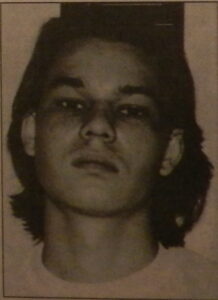
Davis ripped into Kuns’ assertion that he didn’t know what he was doing the night he repeatedly drove a knife into her son, pointing to court testimony and comments Kuns is said to have made about the murder.
“This is a picture of our family, which no longer exists because of Mr. Kuns,” she said. “Trying to maintain any kind of family after someone in it has been murdered is impossible,” she said.
“Every holiday, every birthday and every event that happens causes nothing but harm…. He would have done all of us a service had he killed us all because none of us remaining have had anything like a normal life since we lost Ben.”
Kuns never looked at Davis as she testified. His deep, brooding eyes remained glued to the table in front of him. His fingers fidgeted nervously.
“Mr. Kuns committed the crime,” Davis told the board. “But he’s not the one who is doing the time…. Me, my family and my son’s friends are the ones doing the time. And we will be doing it for the rest of our lives.”
Kuns was the last one to speak. Raising his voice slightly, he told the board members he knew he had committed a horrendous crime and understood he needed help. He told them he would keep working to improve himself.
The board recessed for less than a half-hour before returning with its decision: Kuns was denied a parole date. He was sent back behind bars, not to return before the board again for two years.
Moments after the decision as read, Davis and the prosecutor expressed relief that Kuns would not be on the streets any time soon.
“That KKK stuff was a killer for him,” Los Angeles County Deputy District Attorney Mitchel Harris said. “If he comes to the hearings with these attitudes and these reports, he’ll never get out,” he said. “And that’s appropriate. He’s still a man full of rage.”
Davis called the outcome a victory, but said the road ahead of her, like the highway leading to the prison, would be long and hard.
“I feel greatly relieved… but I have a lot of work ahead of me on this,” she said. “What would you call it? A crusade?”
[]
Prison can eat at a man’s soul.
It’s been chewing at David Kuns’ for nearly half his life.
For 12 years Kuns has called the cell blocks of San Quentin and Soledad state prisons home. He is serving a15 years-to-life sentence for the murder of Denis Benjamin Davis.
Kuns was a 17-year-old foster child living in Whittier when he and a friend abducted Davis, stabbed him repeatedly and dumped him over a cliff in Turnbull Canyon.
He was 19 by the time he pleaded guilty to second-degree murder in Pomona Superior Court in 1981.
In October of that year, David Jay Kuns walked into the state prison system a cocky young convicted killer who, by his own admission, showed no remorse for the crime he committed.
Now, on this lazy afternoon 14 years after the murder, some 400 miles away from Whittier, Kuns is thinking about life on the outside again.
It’s the day before he’s scheduled to go in front of the parole board, and Kuns, 31, is thinking about the freedom he kissed goodbye so long ago.
He sits hunched over a table inside a small room at the Deuel Vocational Institution. His slim frame is clothed in a blue denim prison uniform, his hair cropped short and starting to recede. His brown eyes squint as he offers a big, if slightly nervous, smile.
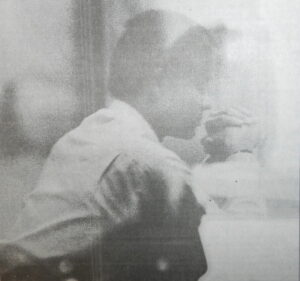
Outside the prison setting, it might be hard to imagine that Kuns had committed a savage murder that summer of 1979. Kuns said he has a hard time believing it himself.
“I’m not the same man. I’m not the same person,” he said, speaking so softly that at times his voice is barely audible. “My whole life has totally changed.”
While Kuns said he accepts responsibility for the killing, he blames the crime on a teen gone wild – thrown out of his home by his parents. A teen who dropped out of Whittier High School and took up drinking hard liquor and smoking PCP.
Kuns said he was so high the night of the murder he has only one brief memory of the attack.
“I do remember one thing: I do remember stabbing him once… We must have been in the car,” he said. “I was blacked out from drinking. The board doesn’t believe me… They think I have to remember something, but I really was blacked out.”
Kuns said when he learned what had happened the day after the attack – Davis didn’t die until two days later – he was terrified. But he never considered turning himself into police.
Even after being arrested and convicted, Kuns said he spent his first year in prison in denial. He was unable to accept the gravity of his situation.
Since then, however, Kuns said he has worked hard to change his attitude. He’s been reading the Bible and attending to his personal health.
“Pretty much immediately, I knew I had to clean myself up,” Kuns said. “It can go two ways. You’re allowed television in here and you can veg in front of that, or you can make yourself grow. And that’s what I have tried to do.”
Kuns said he has never communicated with Davis’ mother, Coleen, about her son’s murder. But he has thought about it, and this is what he would say: “(The murder) was very horrendous and unfortunate. It wasn’t meant to happen, was nothing against your son. It was just that I was out of it.”
Although Kuns said he believes he will be set free one day, it would not be this time, not this year.
And even if he remains behind bars until he is old and gray, Kuns said he has made peace with himself.
“Have I been forgiven? By God, yes. But that doesn’t mean I don’t have to suffer the consequences,” he said.
[]
Denis Benjamin Davis probably never saw his death coming, though it drove by him several times the last night of his life.
He could not have known, as a car carrying two Whitter teen-agers circled him, that his life was about to end in one of the most violent murders ever to rock the community.
Sgt. Mike Garrahan, the Whittier patrol officer who took the missing person report from Ben Davis’ mother, said the brutality of the killing remains ingrained in his memory.
“We didn’t have a lot of murders back then. To have a young, middle-class kid abducted and killed like that was very shocking,” Garrahan said. “Every time I drive into Turnbull Canyon I think of Ben Davis.”
In the early morning of April 29, 1979, 15-year-old Ben was walking home drunk from a party. He had brushed off offers of a ride, hoping he could walk off the effects of the beer and marijuana he’d consumed.
As he walked along Bailey Street, Ben was spotted by 17-year-old David Kuns and his buddy Fredrick Munoz, 19. Both had been at the same party.
Like Ben, Kuns and Munoz has been drinking heavily. The pair were on their way to buy more beer when they spotted Ben stumbling toward home, according to sheriff’s investigators’ reports.
Kuns told Munoz, who was behind the wheel of his parents’ station wagon, to pull over so he could “roll” Ben, according to the reports.
Munoz balked, but circled the block several times before finally pulling over near Ben. Kuns jumped out of the vehicle, Munoz later told investigators, and began beating Ben, who was in no condition to defend himself.
Kuns pulled him into the back seat and told Munoz to start driving. Munoz headed toward Turnbull Canyon.
In the back seat, Kuns began to plunge a knife into Ben’s body. By the time he was done, he had stabbed him more than 20 times. Munoz would later say he didn’t know Kuns was stabbing Ben.
How much Ben was able to struggle is unclear, but he reportedly pleaded, “Please leave me alone.”
Munoz stopped the car on Edgeridge Drive, and Kuns dragged Ben out of the car. Throwing Ben over the side of the canyon road, Kuns went after him, hiking down the steep canyon face to attack him where he lay, according to police and court records.
After it was over, Munoz told Kuns to throw the knife into the canyon.
Nearly two days after the attack, bleeding heavily and suffering from exposure, the mortally wounded boy managed to climb out of the canyon. He sat hunched at the side of the road until a passer-by pulled over to help him shortly after 2 p.m. April 30.
Ben was taken to Queen of the Valley Hospital in West Covina where he lingered for two more days. He died early in the morning May 2.
The murder struck Whittier to the core. Bold headlines appeared atop newspapers as investigations scrambled for leads in the case.
Lt. Larry Bodenstedt worked in the sheriff’s homicide bureau at the time and was assigned the case. It is a memory he too has had a hard time shaking.
“He was just a little 15-year-old kid. They could have taken anything they wanted from him, especially in his condition,” Bodenstedt said. “To stab him, throw him off a cliff and then go after him? It was vicious.”
Sources called authorities within days of the murder, supplying information incriminating Kuns and Munoz. The pair were arrested not long after the murder. They were later released because of a lack of evidence.
After two years spent building a case and tracking Munoz, who had fled, Bodenstedt and his partner arrested them again.
Munoz accepted a reduced charge in exchange for his testimony. “As soon as Munoz talked, Kuns wanted to play ‘let’s make a deal,’” Bodenstedt said.
Ben is buried at Rose Hills. Munoz has been released; his whereabouts are unknown. Kuns is serving 15 years to life at the Deuel Vocational Institution in Tracy.
[]
It’s strange talking with a killer.
Covering gangs for the past few years, I know I’ve spoken with more than one person who has ended another’s life. But it was always an implied crime, a dark accomplishment that gang members took pleasure hinting at, but never admitting.
When I sat down with David Jay Kuns last week inside a state prison in Tracy, about 20 miles southwest of Stockton, one of the last vestiges of my crime reporting naivete was lost.
I knew I was talking with a convicted killer – a guy who sheepishly admits to dragging a 15-year-old boy off the streets of Whittier one summer night in 1979, beating him, stabbing him and throwing him off a cliff.
As I was led through the prison to the small meeting room where Kuns and I were to talk, I began to brace myself for the animal I knew would greet me.
A mental picture had already appeared, sort of a hybrid of death. I had a clear vision of a man with Charlie Manson eyes, a Ted Bundy smile and a Richard Ramirez attitude.
Looking back, I probably should have known better than to expect something, or somebody, so stereotypically packaged. The killer I sat down with wasn’t a caricature of walking evil. Other than a pair of brooding eyes, Kuns has no remarkable characteristics.
Instead, I was confronted with an obviously nervous young man who seemed genuinely sorry for the crime he committed.
The interview proved to be a mix of predictability and surprise.
I was told beforehand that Kuns had “found God” while behind bars, so I anticipated a conversion story al a Tex Watson of the sinister Charles Manson family.
Kuns mentioned his religion once, and only when asked.
He didn’t give many details of the murder either. The killing was shrouded in an impenetrable, alcohol-induced haze, he said. The cries of a 15-year-old boy being hacked to death have long since faded.
Despite his memory loss, Kuns never shied away from taking responsibility for the crime itself or surprisingly, from the price he’s had to pay.
He entered the state prison system a teen-ager and, now in his 30s, has spent some of the best years of his life behind bars.
Prison is not “three hots and a cot.” The country club stories I’d heard about life behind bars evaporated as I took a good look at Kuns and the nightmare he calls home.
Kuns has been slow burning in his prison hell for 12 years and in all likelihood will rot behind bars for another eight before he has any real chance at parole.
The reality of this seemed to register in his eyes, dulling what light they held when I asked him what it was like waking up every morning in that closet-size cell.
By the time I completed the assignment three days later, I actually was experiencing what I once thought impossible: sympathy for a killer.
It was an honest emotion, but one that didn’t last too long after I left those prison gates behind.
Any sympathy I had was diluted by the cold reality of what Kuns did to Denis Benjamin Davis. Maybe Kuns can’t remember what happened that night, but I can’t forget the 18 glossy color photographs contained in the homicide file.
Kuns has lost his freedom. Davis lost his life.
And while Kuns serves his sentence, Mrs. Davis serves hers, with near-daily reminders of the son snatched from her in a manner that defies any attempt at reason.
I looked at those homicide photos a long time, until I was almost sick. Close-ups of death, they tell any sane individual why Kuns is doing hard time in a very hard place.
David Jay Kuns knows intimately the anguish in the voice of Johnny Cash when he sings “But I know I had it coming, I know I can’t be free… but those people keep a’movin’, and that’s what tortures me.”
Perhaps some day a parole board will decide he’s had enough.
Perhaps not.



